Digital Forensics and Wearable Technology: An Investigative Analysis
VerifiedAdded on 2022/09/25
|7
|1641
|21
Report
AI Summary
This report provides an overview of wearable digital forensic technology, focusing on its application in criminal investigations. It explores the advantages of using data from wearable devices like smartwatches and fitness trackers, such as providing authentic location, time, and activity information, potentially replacing traditional witness testimonies. The report also addresses challenges, including legal and ethical issues, technological glitches, data security concerns, and the complexities of multiple users of a single device. Real-world case scenarios, like using data from a Fitbit in a murder case, are presented to illustrate the practical use of wearable technology in investigations. The analysis emphasizes the importance of preserving evidence and the need for legitimate and accurate data analysis methods. The report concludes by highlighting the evolving nature of digital forensics and the ongoing need for specialized approaches to evidence collection and analysis in the context of rapidly advancing technologies. The report also mentions that the website offers past papers and solved assignments.
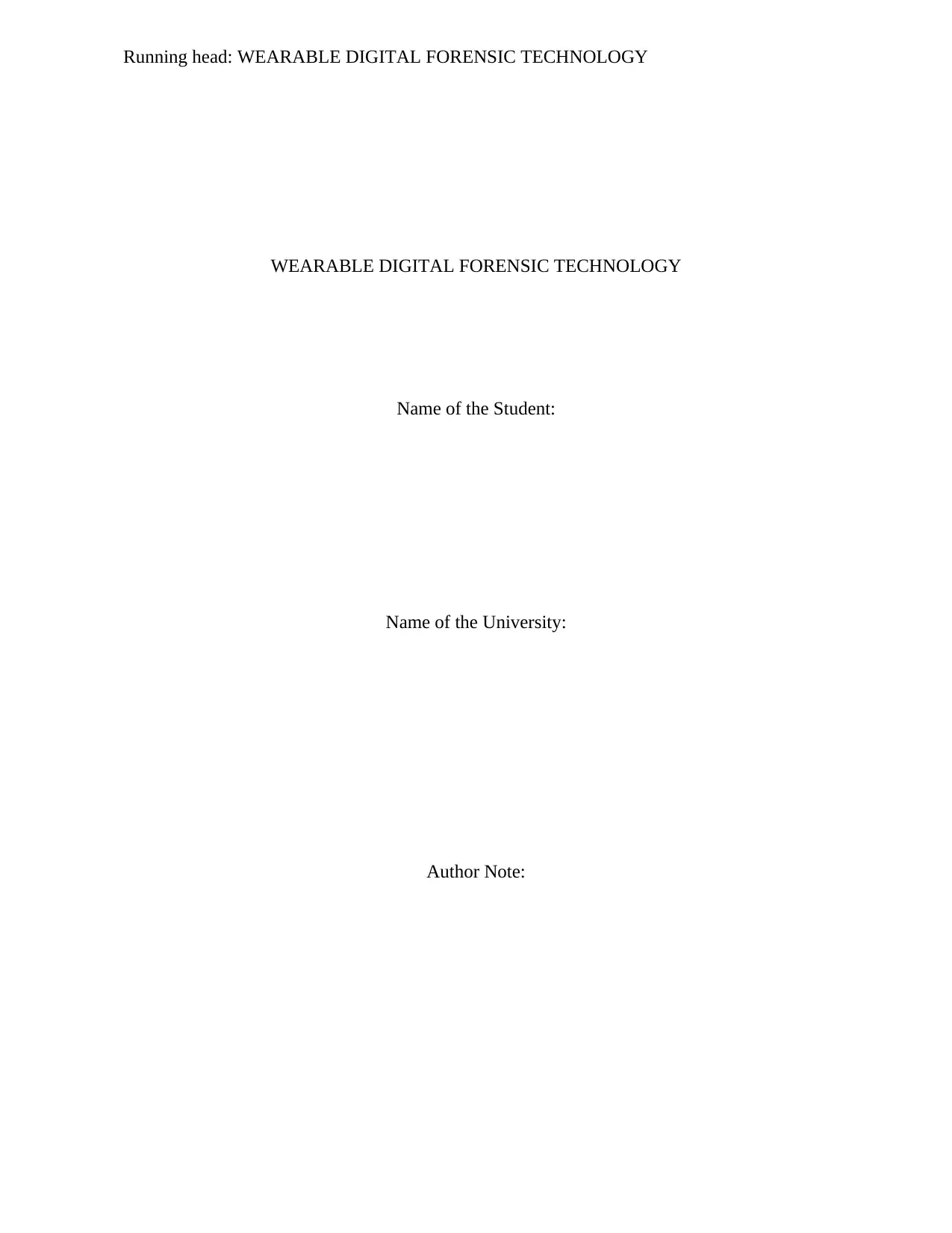
Running head: WEARABLE DIGITAL FORENSIC TECHNOLOGY
WEARABLE DIGITAL FORENSIC TECHNOLOGY
Name of the Student:
Name of the University:
Author Note:
WEARABLE DIGITAL FORENSIC TECHNOLOGY
Name of the Student:
Name of the University:
Author Note:
Paraphrase This Document
Need a fresh take? Get an instant paraphrase of this document with our AI Paraphraser
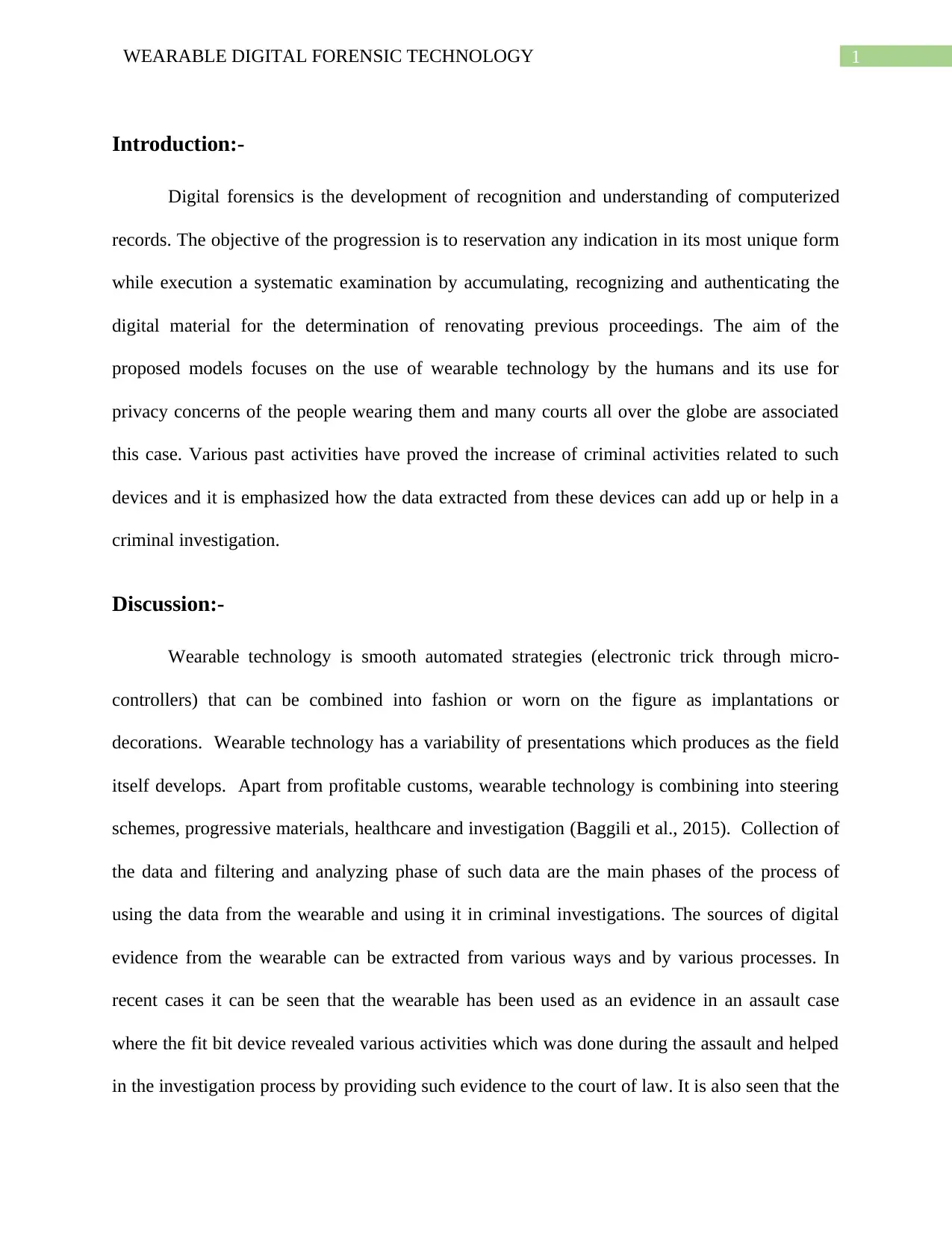
1WEARABLE DIGITAL FORENSIC TECHNOLOGY
Introduction:-
Digital forensics is the development of recognition and understanding of computerized
records. The objective of the progression is to reservation any indication in its most unique form
while execution a systematic examination by accumulating, recognizing and authenticating the
digital material for the determination of renovating previous proceedings. The aim of the
proposed models focuses on the use of wearable technology by the humans and its use for
privacy concerns of the people wearing them and many courts all over the globe are associated
this case. Various past activities have proved the increase of criminal activities related to such
devices and it is emphasized how the data extracted from these devices can add up or help in a
criminal investigation.
Discussion:-
Wearable technology is smooth automated strategies (electronic trick through micro-
controllers) that can be combined into fashion or worn on the figure as implantations or
decorations. Wearable technology has a variability of presentations which produces as the field
itself develops. Apart from profitable customs, wearable technology is combining into steering
schemes, progressive materials, healthcare and investigation (Baggili et al., 2015). Collection of
the data and filtering and analyzing phase of such data are the main phases of the process of
using the data from the wearable and using it in criminal investigations. The sources of digital
evidence from the wearable can be extracted from various ways and by various processes. In
recent cases it can be seen that the wearable has been used as an evidence in an assault case
where the fit bit device revealed various activities which was done during the assault and helped
in the investigation process by providing such evidence to the court of law. It is also seen that the
Introduction:-
Digital forensics is the development of recognition and understanding of computerized
records. The objective of the progression is to reservation any indication in its most unique form
while execution a systematic examination by accumulating, recognizing and authenticating the
digital material for the determination of renovating previous proceedings. The aim of the
proposed models focuses on the use of wearable technology by the humans and its use for
privacy concerns of the people wearing them and many courts all over the globe are associated
this case. Various past activities have proved the increase of criminal activities related to such
devices and it is emphasized how the data extracted from these devices can add up or help in a
criminal investigation.
Discussion:-
Wearable technology is smooth automated strategies (electronic trick through micro-
controllers) that can be combined into fashion or worn on the figure as implantations or
decorations. Wearable technology has a variability of presentations which produces as the field
itself develops. Apart from profitable customs, wearable technology is combining into steering
schemes, progressive materials, healthcare and investigation (Baggili et al., 2015). Collection of
the data and filtering and analyzing phase of such data are the main phases of the process of
using the data from the wearable and using it in criminal investigations. The sources of digital
evidence from the wearable can be extracted from various ways and by various processes. In
recent cases it can be seen that the wearable has been used as an evidence in an assault case
where the fit bit device revealed various activities which was done during the assault and helped
in the investigation process by providing such evidence to the court of law. It is also seen that the
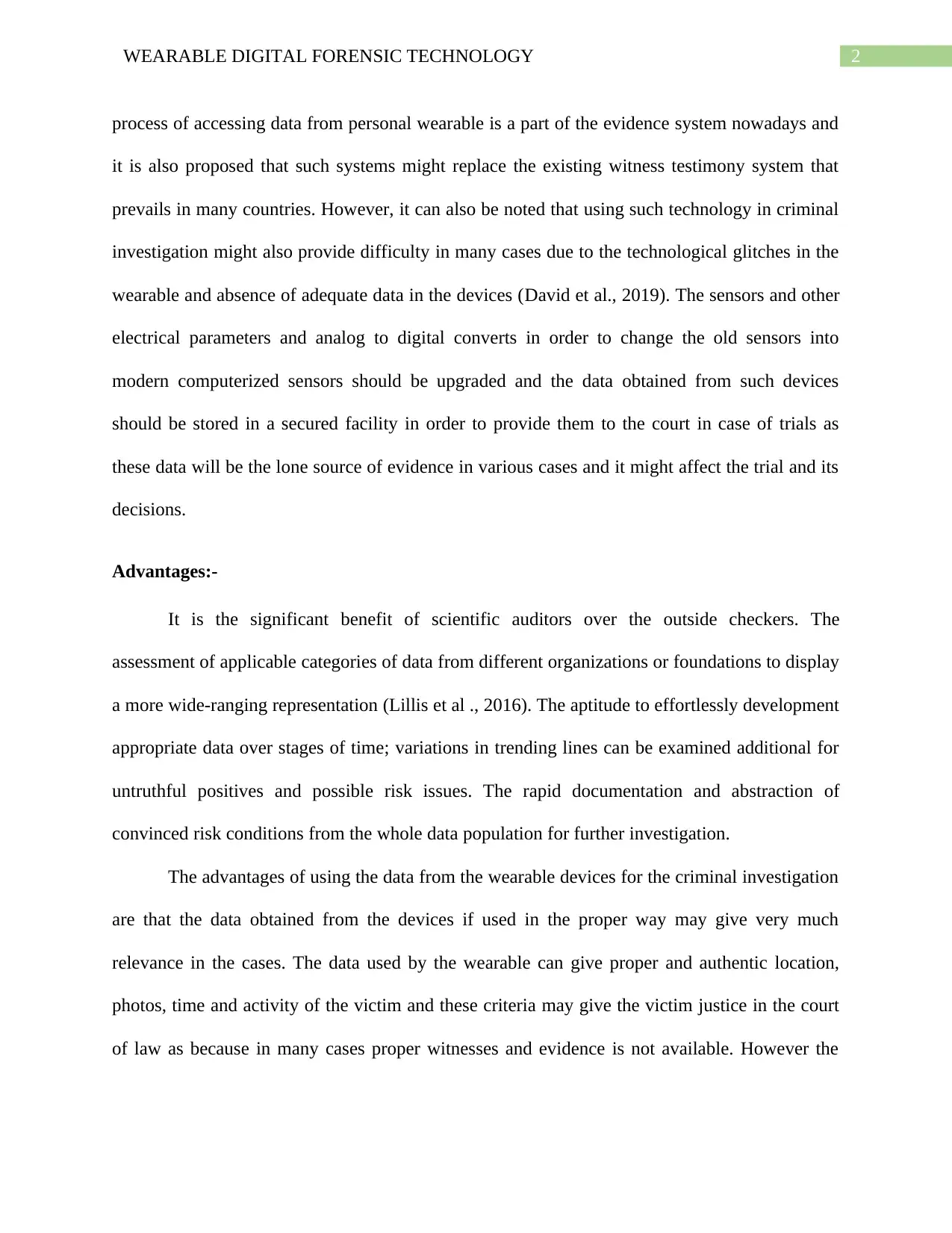
2WEARABLE DIGITAL FORENSIC TECHNOLOGY
process of accessing data from personal wearable is a part of the evidence system nowadays and
it is also proposed that such systems might replace the existing witness testimony system that
prevails in many countries. However, it can also be noted that using such technology in criminal
investigation might also provide difficulty in many cases due to the technological glitches in the
wearable and absence of adequate data in the devices (David et al., 2019). The sensors and other
electrical parameters and analog to digital converts in order to change the old sensors into
modern computerized sensors should be upgraded and the data obtained from such devices
should be stored in a secured facility in order to provide them to the court in case of trials as
these data will be the lone source of evidence in various cases and it might affect the trial and its
decisions.
Advantages:-
It is the significant benefit of scientific auditors over the outside checkers. The
assessment of applicable categories of data from different organizations or foundations to display
a more wide-ranging representation (Lillis et al ., 2016). The aptitude to effortlessly development
appropriate data over stages of time; variations in trending lines can be examined additional for
untruthful positives and possible risk issues. The rapid documentation and abstraction of
convinced risk conditions from the whole data population for further investigation.
The advantages of using the data from the wearable devices for the criminal investigation
are that the data obtained from the devices if used in the proper way may give very much
relevance in the cases. The data used by the wearable can give proper and authentic location,
photos, time and activity of the victim and these criteria may give the victim justice in the court
of law as because in many cases proper witnesses and evidence is not available. However the
process of accessing data from personal wearable is a part of the evidence system nowadays and
it is also proposed that such systems might replace the existing witness testimony system that
prevails in many countries. However, it can also be noted that using such technology in criminal
investigation might also provide difficulty in many cases due to the technological glitches in the
wearable and absence of adequate data in the devices (David et al., 2019). The sensors and other
electrical parameters and analog to digital converts in order to change the old sensors into
modern computerized sensors should be upgraded and the data obtained from such devices
should be stored in a secured facility in order to provide them to the court in case of trials as
these data will be the lone source of evidence in various cases and it might affect the trial and its
decisions.
Advantages:-
It is the significant benefit of scientific auditors over the outside checkers. The
assessment of applicable categories of data from different organizations or foundations to display
a more wide-ranging representation (Lillis et al ., 2016). The aptitude to effortlessly development
appropriate data over stages of time; variations in trending lines can be examined additional for
untruthful positives and possible risk issues. The rapid documentation and abstraction of
convinced risk conditions from the whole data population for further investigation.
The advantages of using the data from the wearable devices for the criminal investigation
are that the data obtained from the devices if used in the proper way may give very much
relevance in the cases. The data used by the wearable can give proper and authentic location,
photos, time and activity of the victim and these criteria may give the victim justice in the court
of law as because in many cases proper witnesses and evidence is not available. However the
⊘ This is a preview!⊘
Do you want full access?
Subscribe today to unlock all pages.

Trusted by 1+ million students worldwide
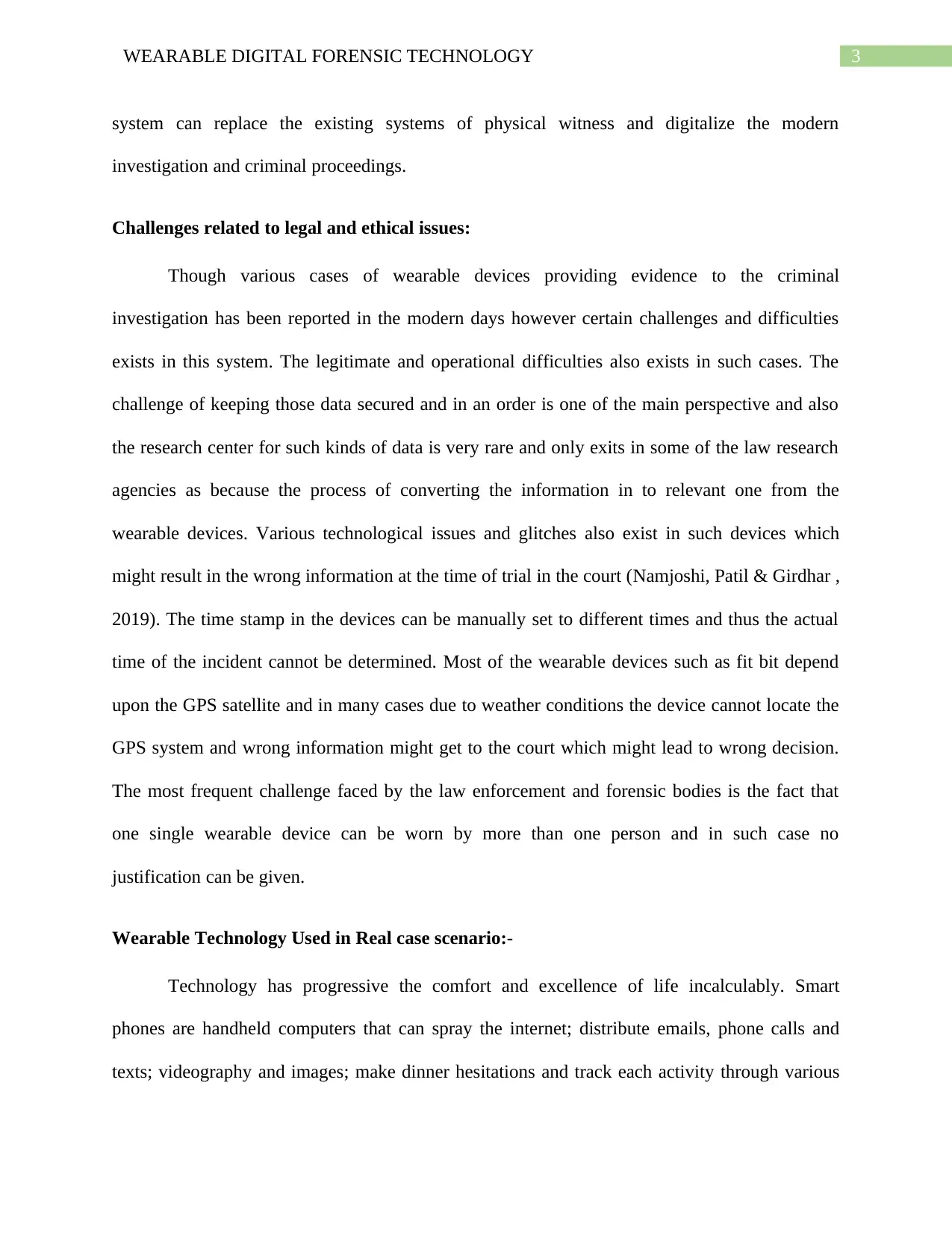
3WEARABLE DIGITAL FORENSIC TECHNOLOGY
system can replace the existing systems of physical witness and digitalize the modern
investigation and criminal proceedings.
Challenges related to legal and ethical issues:
Though various cases of wearable devices providing evidence to the criminal
investigation has been reported in the modern days however certain challenges and difficulties
exists in this system. The legitimate and operational difficulties also exists in such cases. The
challenge of keeping those data secured and in an order is one of the main perspective and also
the research center for such kinds of data is very rare and only exits in some of the law research
agencies as because the process of converting the information in to relevant one from the
wearable devices. Various technological issues and glitches also exist in such devices which
might result in the wrong information at the time of trial in the court (Namjoshi, Patil & Girdhar ,
2019). The time stamp in the devices can be manually set to different times and thus the actual
time of the incident cannot be determined. Most of the wearable devices such as fit bit depend
upon the GPS satellite and in many cases due to weather conditions the device cannot locate the
GPS system and wrong information might get to the court which might lead to wrong decision.
The most frequent challenge faced by the law enforcement and forensic bodies is the fact that
one single wearable device can be worn by more than one person and in such case no
justification can be given.
Wearable Technology Used in Real case scenario:-
Technology has progressive the comfort and excellence of life incalculably. Smart
phones are handheld computers that can spray the internet; distribute emails, phone calls and
texts; videography and images; make dinner hesitations and track each activity through various
system can replace the existing systems of physical witness and digitalize the modern
investigation and criminal proceedings.
Challenges related to legal and ethical issues:
Though various cases of wearable devices providing evidence to the criminal
investigation has been reported in the modern days however certain challenges and difficulties
exists in this system. The legitimate and operational difficulties also exists in such cases. The
challenge of keeping those data secured and in an order is one of the main perspective and also
the research center for such kinds of data is very rare and only exits in some of the law research
agencies as because the process of converting the information in to relevant one from the
wearable devices. Various technological issues and glitches also exist in such devices which
might result in the wrong information at the time of trial in the court (Namjoshi, Patil & Girdhar ,
2019). The time stamp in the devices can be manually set to different times and thus the actual
time of the incident cannot be determined. Most of the wearable devices such as fit bit depend
upon the GPS satellite and in many cases due to weather conditions the device cannot locate the
GPS system and wrong information might get to the court which might lead to wrong decision.
The most frequent challenge faced by the law enforcement and forensic bodies is the fact that
one single wearable device can be worn by more than one person and in such case no
justification can be given.
Wearable Technology Used in Real case scenario:-
Technology has progressive the comfort and excellence of life incalculably. Smart
phones are handheld computers that can spray the internet; distribute emails, phone calls and
texts; videography and images; make dinner hesitations and track each activity through various
Paraphrase This Document
Need a fresh take? Get an instant paraphrase of this document with our AI Paraphraser
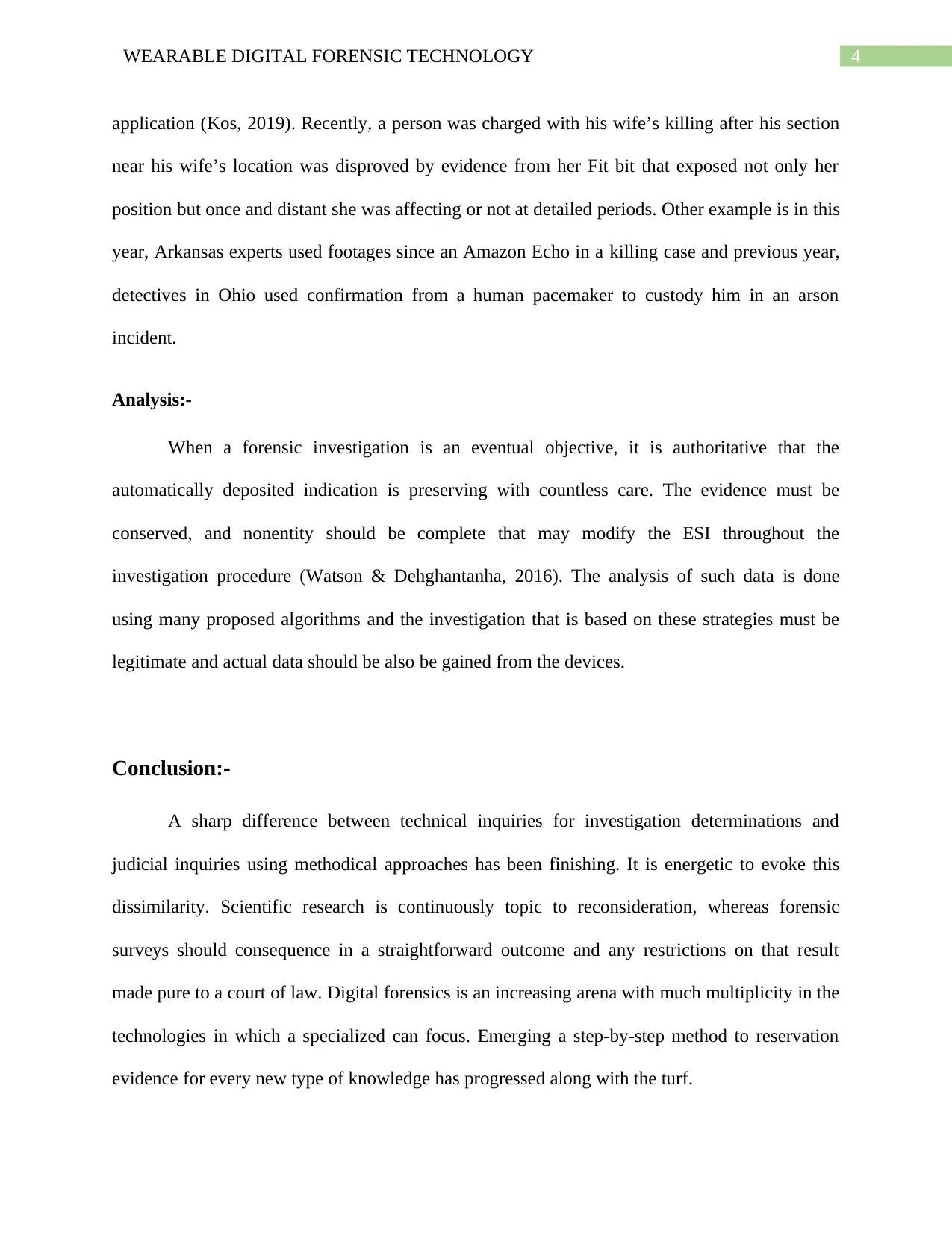
4WEARABLE DIGITAL FORENSIC TECHNOLOGY
application (Kos, 2019). Recently, a person was charged with his wife’s killing after his section
near his wife’s location was disproved by evidence from her Fit bit that exposed not only her
position but once and distant she was affecting or not at detailed periods. Other example is in this
year, Arkansas experts used footages since an Amazon Echo in a killing case and previous year,
detectives in Ohio used confirmation from a human pacemaker to custody him in an arson
incident.
Analysis:-
When a forensic investigation is an eventual objective, it is authoritative that the
automatically deposited indication is preserving with countless care. The evidence must be
conserved, and nonentity should be complete that may modify the ESI throughout the
investigation procedure (Watson & Dehghantanha, 2016). The analysis of such data is done
using many proposed algorithms and the investigation that is based on these strategies must be
legitimate and actual data should be also be gained from the devices.
Conclusion:-
A sharp difference between technical inquiries for investigation determinations and
judicial inquiries using methodical approaches has been finishing. It is energetic to evoke this
dissimilarity. Scientific research is continuously topic to reconsideration, whereas forensic
surveys should consequence in a straightforward outcome and any restrictions on that result
made pure to a court of law. Digital forensics is an increasing arena with much multiplicity in the
technologies in which a specialized can focus. Emerging a step-by-step method to reservation
evidence for every new type of knowledge has progressed along with the turf.
application (Kos, 2019). Recently, a person was charged with his wife’s killing after his section
near his wife’s location was disproved by evidence from her Fit bit that exposed not only her
position but once and distant she was affecting or not at detailed periods. Other example is in this
year, Arkansas experts used footages since an Amazon Echo in a killing case and previous year,
detectives in Ohio used confirmation from a human pacemaker to custody him in an arson
incident.
Analysis:-
When a forensic investigation is an eventual objective, it is authoritative that the
automatically deposited indication is preserving with countless care. The evidence must be
conserved, and nonentity should be complete that may modify the ESI throughout the
investigation procedure (Watson & Dehghantanha, 2016). The analysis of such data is done
using many proposed algorithms and the investigation that is based on these strategies must be
legitimate and actual data should be also be gained from the devices.
Conclusion:-
A sharp difference between technical inquiries for investigation determinations and
judicial inquiries using methodical approaches has been finishing. It is energetic to evoke this
dissimilarity. Scientific research is continuously topic to reconsideration, whereas forensic
surveys should consequence in a straightforward outcome and any restrictions on that result
made pure to a court of law. Digital forensics is an increasing arena with much multiplicity in the
technologies in which a specialized can focus. Emerging a step-by-step method to reservation
evidence for every new type of knowledge has progressed along with the turf.
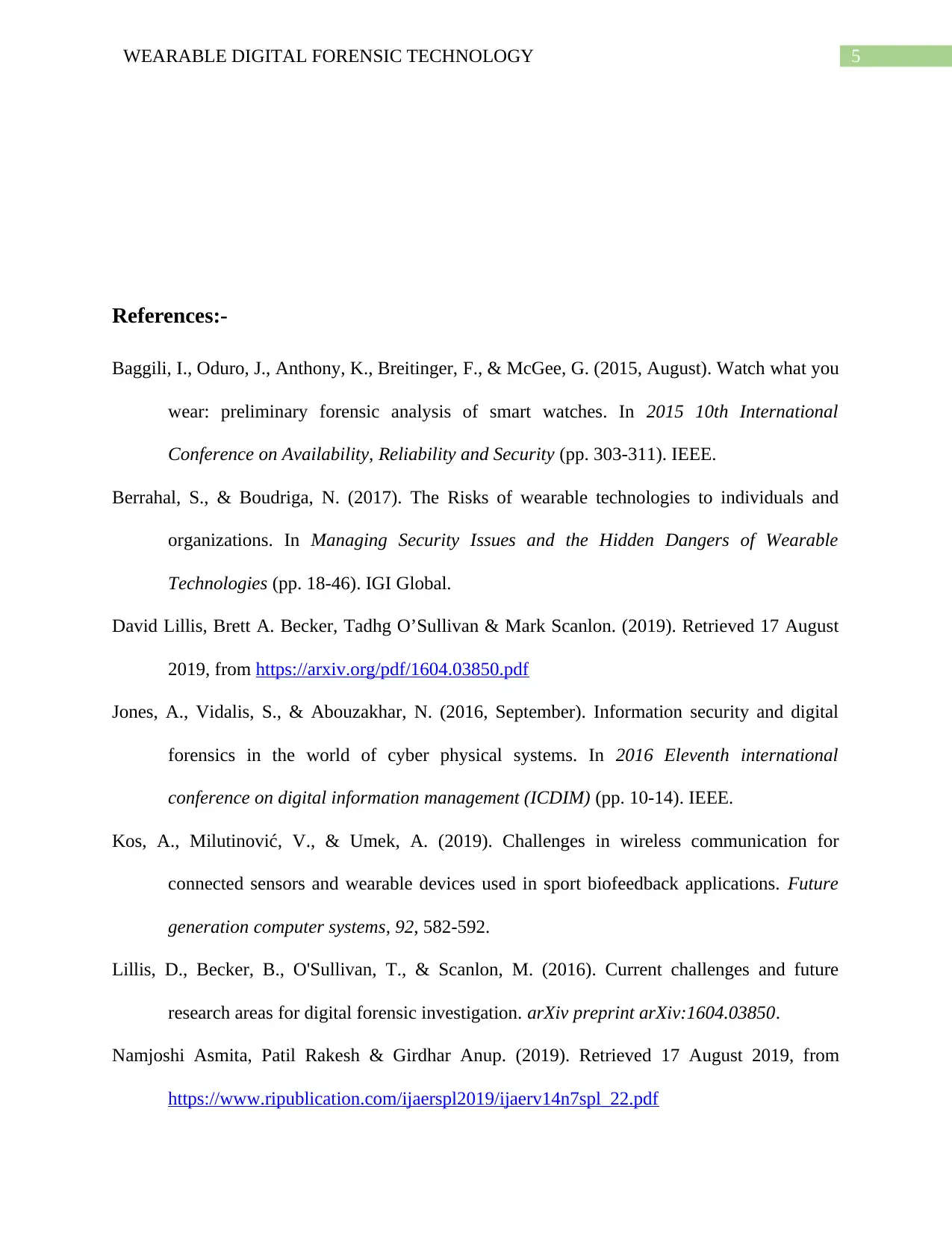
5WEARABLE DIGITAL FORENSIC TECHNOLOGY
References:-
Baggili, I., Oduro, J., Anthony, K., Breitinger, F., & McGee, G. (2015, August). Watch what you
wear: preliminary forensic analysis of smart watches. In 2015 10th International
Conference on Availability, Reliability and Security (pp. 303-311). IEEE.
Berrahal, S., & Boudriga, N. (2017). The Risks of wearable technologies to individuals and
organizations. In Managing Security Issues and the Hidden Dangers of Wearable
Technologies (pp. 18-46). IGI Global.
David Lillis, Brett A. Becker, Tadhg O’Sullivan & Mark Scanlon. (2019). Retrieved 17 August
2019, from https://arxiv.org/pdf/1604.03850.pdf
Jones, A., Vidalis, S., & Abouzakhar, N. (2016, September). Information security and digital
forensics in the world of cyber physical systems. In 2016 Eleventh international
conference on digital information management (ICDIM) (pp. 10-14). IEEE.
Kos, A., Milutinović, V., & Umek, A. (2019). Challenges in wireless communication for
connected sensors and wearable devices used in sport biofeedback applications. Future
generation computer systems, 92, 582-592.
Lillis, D., Becker, B., O'Sullivan, T., & Scanlon, M. (2016). Current challenges and future
research areas for digital forensic investigation. arXiv preprint arXiv:1604.03850.
Namjoshi Asmita, Patil Rakesh & Girdhar Anup. (2019). Retrieved 17 August 2019, from
https://www.ripublication.com/ijaerspl2019/ijaerv14n7spl_22.pdf
References:-
Baggili, I., Oduro, J., Anthony, K., Breitinger, F., & McGee, G. (2015, August). Watch what you
wear: preliminary forensic analysis of smart watches. In 2015 10th International
Conference on Availability, Reliability and Security (pp. 303-311). IEEE.
Berrahal, S., & Boudriga, N. (2017). The Risks of wearable technologies to individuals and
organizations. In Managing Security Issues and the Hidden Dangers of Wearable
Technologies (pp. 18-46). IGI Global.
David Lillis, Brett A. Becker, Tadhg O’Sullivan & Mark Scanlon. (2019). Retrieved 17 August
2019, from https://arxiv.org/pdf/1604.03850.pdf
Jones, A., Vidalis, S., & Abouzakhar, N. (2016, September). Information security and digital
forensics in the world of cyber physical systems. In 2016 Eleventh international
conference on digital information management (ICDIM) (pp. 10-14). IEEE.
Kos, A., Milutinović, V., & Umek, A. (2019). Challenges in wireless communication for
connected sensors and wearable devices used in sport biofeedback applications. Future
generation computer systems, 92, 582-592.
Lillis, D., Becker, B., O'Sullivan, T., & Scanlon, M. (2016). Current challenges and future
research areas for digital forensic investigation. arXiv preprint arXiv:1604.03850.
Namjoshi Asmita, Patil Rakesh & Girdhar Anup. (2019). Retrieved 17 August 2019, from
https://www.ripublication.com/ijaerspl2019/ijaerv14n7spl_22.pdf
⊘ This is a preview!⊘
Do you want full access?
Subscribe today to unlock all pages.

Trusted by 1+ million students worldwide
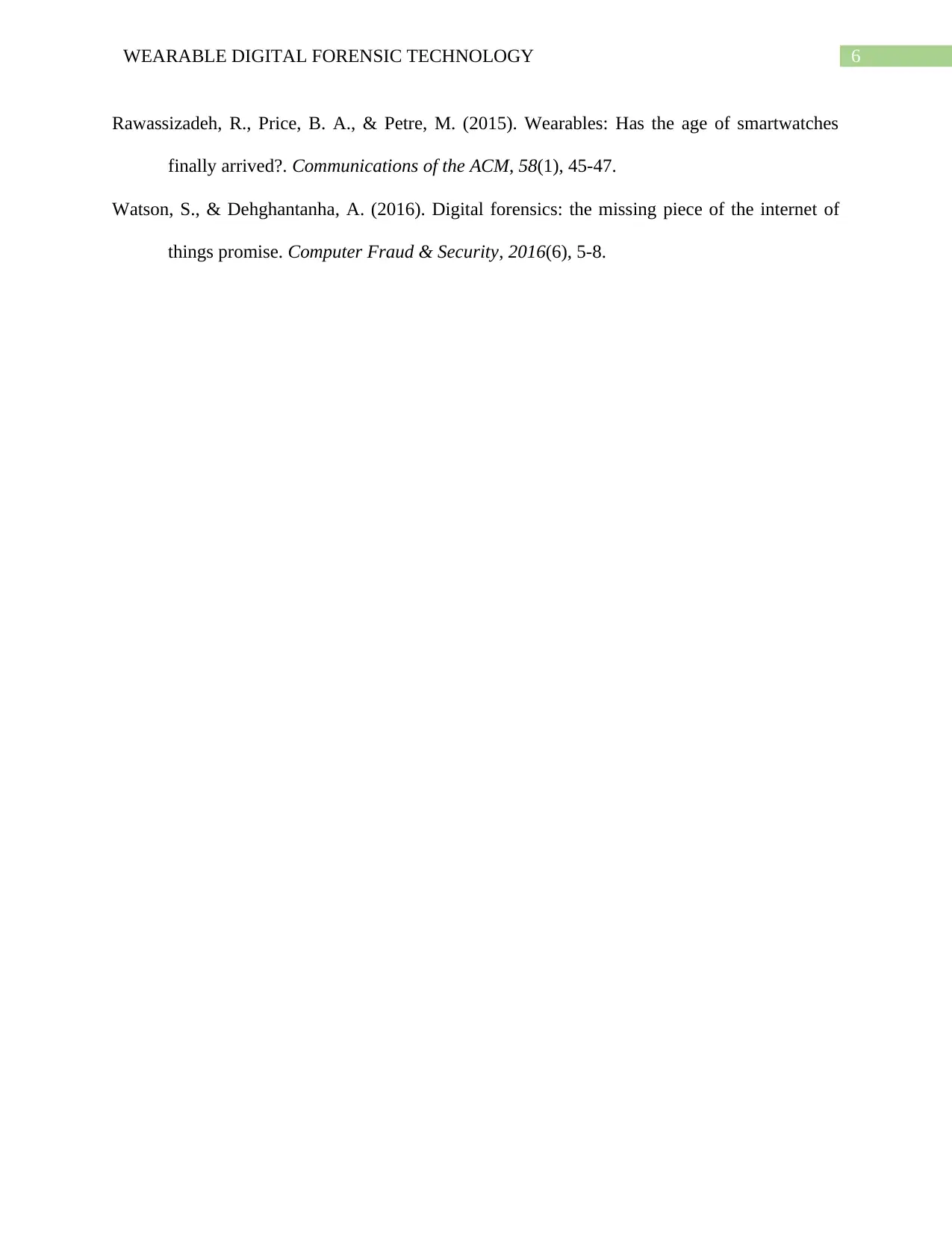
6WEARABLE DIGITAL FORENSIC TECHNOLOGY
Rawassizadeh, R., Price, B. A., & Petre, M. (2015). Wearables: Has the age of smartwatches
finally arrived?. Communications of the ACM, 58(1), 45-47.
Watson, S., & Dehghantanha, A. (2016). Digital forensics: the missing piece of the internet of
things promise. Computer Fraud & Security, 2016(6), 5-8.
Rawassizadeh, R., Price, B. A., & Petre, M. (2015). Wearables: Has the age of smartwatches
finally arrived?. Communications of the ACM, 58(1), 45-47.
Watson, S., & Dehghantanha, A. (2016). Digital forensics: the missing piece of the internet of
things promise. Computer Fraud & Security, 2016(6), 5-8.
1 out of 7
Related Documents
Your All-in-One AI-Powered Toolkit for Academic Success.
+13062052269
info@desklib.com
Available 24*7 on WhatsApp / Email
![[object Object]](/_next/static/media/star-bottom.7253800d.svg)
Unlock your academic potential
Copyright © 2020–2025 A2Z Services. All Rights Reserved. Developed and managed by ZUCOL.





